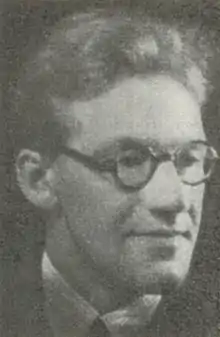Olav Dalgard
Olav Dalgard (19 June 1898 – 25 December 1980) was a Norwegian literary and art historian, filmmaker, author and educator. [1]

Biography
Dalgard was born Olaf Hanssen in Folldal, in Hedmark, Norway. From the age of three, he raised at Oppdal in Trøndelag. He earned an M.A. degree in literature and art history at the University of Oslo in 1929. He was an advocate of the use of Nynorsk and served as the chairman of the student Nynorsk association. He was also in the Mot Dag movement. [2] [3]
Dalgard worked as a literary critic for the newspapers Dagbladet and Arbeiderbladet. Dalgard took over as dramatic advisor and instructor for Det Norske Teateret in 1931 and was attached to the theater for 48 years.
He studied film in the Soviet Union and in the 1930s produced several films with a socialist message. Dalgard was also active in the Norwegian Labour Party's cultural operations. During the Occupation of Norway by Nazi Germany, Dalgard was arrested in 1942, held as a political prisoner by German authorities and sent to the Sachsenhausen concentration camp.[4]
Dalgard was involved in the establishment of the Norwegian Film Institute and was a member of the state film board. Among his most famous works was Gryr i Norden (1939). Dalgard both wrote the script and directed the film which was a dramatization of the Kristiania Match Workers Strike of 1889 (fyrstikkarbeiderstreiken). He also wrote a number of books about theater and film as well as biographies including Teateret frå Aiskylos til Ibsen (1948), Filmskuespillet – sakprosa (1951), Teateret i det 20. hundreåret – sakprosa (1955), Lars Tvinde – biografi over Lars Tvinde (1966) and Inge Krokann – biografi over Inge Krokann (1970).[5]
Dalgard was chairman of the Norwegian Literature Critics' Association from 1953–55, and president of the Norwegian Humanist Association from 1965-77. From 1961, Dalgard received a government grant. He was a lecturer in theater history at The Norwegian National Academy of Theatre (Statens teaterhøgskole) and at the Department of Theater Science at the University of Oslo.[6]
Selected works
- Europeisk drama frå antikken til realismen (1972) ISBN 9788252100204
- Politikk, kunstliv og kulturkamp i mellomkrigstida (1973) ISBN 82-10-00776-9
- Teatret frå Aiskylos til Ibsen (1974) ISBN 9788252103908
- Teatret i det 20.hundreåret (1976) ISBN 9788252106077
- Krig og etterkrigsproblem (1978) ISBN 82-10-01473-0
Personal life
In 1926, he married Anna Marie Sorteberg (1897–1968). They resided at Voll in Akershus.
In 1978 he accepted the Arts Council Norway Honorary Award (Norsk Kulturråds ærespris) and in 1979 he received the Literary Collection Literature Prize (Språklig samlings litteraturpris). [7]
Dalgard died at Bærum during 1980. Olav Dalgards kritikarpris (Dalgards kritikarpris) was awarded the first time in 1981. It is given annually to a reviewer in literature, film, or theater by the Norwegian Critics Association (Kritikerlaget). [8]
References
- Lillian Bikset. "Olav Dalgard". Store norske leksikon. Retrieved May 1, 2018.
- Kari Gaarder Losnedahl. "Olav Dalgard". Norsk biografisk leksikon. Retrieved May 1, 2018.
- "Mot Dag". leksikon.org. Retrieved May 1, 2018.
- "Olav Dalgard". Allkunne. Retrieved June 1, 2018.
- Knut Dørum. "fyrstikkarbeiderstreiken". Store norske leksikon. Retrieved June 1, 2018.
- Thingsaker, Bjørn. "fyrstikkarbeiderstreiken". In Henriksen, Petter (ed.). Store norske leksikon (in Norwegian). Oslo: Kunnskapsforlaget. Retrieved 8 March 2010.
- "Hvem bor hvor". Asker og Bærums Budstikke (in Norwegian). 10 September 1934. p. 2.
- "Olav Dalgards kritikarpris". Kritikerlaget. Retrieved May 1, 2018.
External links
- Olav Dalgard at IMDb
| Awards | ||
|---|---|---|
| Preceded by Ella Hval |
Recipient of the Norsk kulturråds ærespris 1978 |
Succeeded by Harald Sæverud |